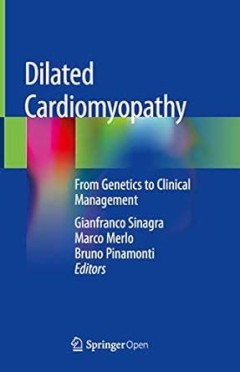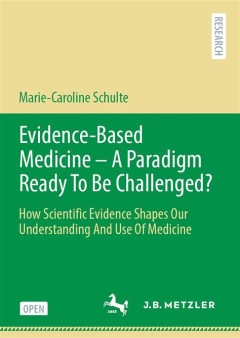Filter by

Global Challenges in Cardiovascular Prevention in Populations with Low Socioe…
Cardiovascular Prevention (CVP) has included important technological advances and determined improvements in morbidity and mortality since the last 70 and 60 years. However, in populations with socioeconomic limited resources even basic health preserving tools such as access to a primary care provider and basic drug therapy for diabetes mellitus, high blood pressure, and high cholesterol are n…
- Edition
- 1
- ISBN/ISSN
- 978-3-031-79051-5
- Collation
- XVIII, 272
- Series Title
- -
- Call Number
- -

Dilated Cardiomyopathy = From Genetics to Clinical Management
This open access book presents a comprehensive overview of dilated cardiomyopathy, providing readers with practical guidelines for its clinical management. The first part of the book analyzes in detail the disease’s pathophysiology, its diagnostic work up as well as the prognostic stratification, and illustrates the role of genetics and gene-environment interaction. The second part presents c…
- Edition
- 1
- ISBN/ISSN
- 9783030138646
- Collation
- IX, 241 ill; hlm
- Series Title
- -
- Call Number
- -

Pflege-Report 2020 = Neuausrichtung von Versorgung und Finanzierung
Neuausrichtung von Versorgung und Finanzierung Der Pflege-Report, der in Buchform und als Open-Access-Publikation erscheint, nimmt jährlich relevante Themen der Versorgung von Pflegebedürftigen unter die Lupe. Als Schwerpunkt des Jahres 2020 werden zentrale Reformbereiche der heutigen Leistungs-, Steuerungs- und Finanzierungsstrukturen aufgegriffen und diskutiert Aus dem Inhalt 15 Fachbeit…
- Edition
- 1
- ISBN/ISSN
- 9783662613627
- Collation
- XVI, 295 hlm; ill., lamp.,
- Series Title
- -
- Call Number
- -

Evidence-Based Medicine - A Paradigm Ready To Be Challenged? = How Scientific…
This open access book aims to clarify the term „evidence-based medicine“ (EBM) from a philosophy of science perspective. The author, Marie-Caroline Schulte discusses the importance of evi-dence in medical research and practice with a focus on the ethical and methodological prob-lems of EBM. The claims that EBM can herald a new theory of epistemology and a Kuhnian paradigm will be refuted. T…
- Edition
- 1
- ISBN/ISSN
- 9783476057037
- Collation
- IX, 148 ill; lamp
- Series Title
- -
- Call Number
- -

Evidence-based Positron Emission Tomography = Summary of Recent Meta-analyses…
This open access book summarizes the findings of recent evidence-based articles (meta-analyses) on the use of positron emission tomography (PET) for various clinical indications. It is divided into five main sections, starting with an introduction to PET and meta-analysis. In turn, the second part addresses evidence-based PET in oncology, providing a broad overview of its use for different type…
- Edition
- 1
- ISBN/ISSN
- 9783030477011
- Collation
- VIII, 143 ill; lamp
- Series Title
- -
- Call Number
- -

Methods for Analysing and Reporting EQ-5D Data
This open access book is the first published guide about how to analyse data produced by the EQ-5D, one of the most widely used Patient Reported Outcomes questionnaires world wide. The authors provide practical, clear and comprehensive guidance in five concise chapters. Following an overview of the EQ-5D and its analysis, we describe how the questionnaire data – the EQ-5D profile and EQ VAS …
- Edition
- 1
- ISBN/ISSN
- 9783030476229
- Collation
- XV, 102 ill; lamp
- Series Title
- -
- Call Number
- -

Ein Physiologiemodell für Tactical Combat Casualty Care Training in mobilen …
Julia Hofmann konzipiert in diesem Open Access Buch ein Physiologiemodell für die präzise Simulation bestimmter Verletzungsfolgen und deren Behandlung in einer Computerspielumgebung. Ihre Ergebnisse leisten einen wichtigen Beitrag, um die Ausbildung von Einsatzkräften in der taktischen Verwundetenversorgung mit neuen Medien zu verbessern. Primäre Zielgruppe sind dabei die sogenannten Erst-H…
- Edition
- 1
- ISBN/ISSN
- 9783658302023
- Collation
- XXXV, 347 hlm; ill., lamp.,
- Series Title
- -
- Call Number
- -

Charting Spiritual Care = The Emerging Role of Chaplaincy Records in Global H…
This open access volume is the first academic book on the controversial issue of including spiritual care in integrated electronic medical records (EMR). Based on an international study group comprising researchers from Europe (The Netherlands, Belgium and Switzerland), the United States, Canada, and Australia, this edited collection provides an overview of different charting practices and expe…
- Edition
- 1
- ISBN/ISSN
- 9783030470708
- Collation
- XV, 232 hlm; ill., lamp.,
- Series Title
- -
- Call Number
- -

Bioethics Across the Globe = Rebirthing Bioethics
This open access book addresses a variety of issues relating to bioethics, in order to initiate cross-cultural dialogue. Beginning with the history, it introduces various views on bioethics, based on specific experiences from Japan. It describes how Japan has been confronted with Western bioethics and the ethical issues new to this modern age, and how it has found its foothold as it decides whe…
- Edition
- 1
- ISBN/ISSN
- 9789811535727
- Collation
- XVIII, 146 hlm; ill., lamp.,
- Series Title
- -
- Call Number
- -

Rethinking Causality, Complexity and Evidence for the Unique Patient = A Caus…
This open access book is a unique resource for health professionals who are interested in understanding the philosophical foundations of their daily practice. It provides tools for untangling the motivations and rationality behind the way medicine and healthcare is studied, evaluated and practiced. In particular, it illustrates the impact that thinking about causation, complexity and evidence h…
- Edition
- 1
- ISBN/ISSN
- 9783030412395
- Collation
- XXII, 241 hlm; ill., lamp.,
- Series Title
- -
- Call Number
- -
 Computer Science, Information & General Works
Computer Science, Information & General Works  Philosophy & Psychology
Philosophy & Psychology  Religion
Religion  Social Sciences
Social Sciences  Language
Language  Pure Science
Pure Science  Applied Sciences
Applied Sciences  Art & Recreation
Art & Recreation  Literature
Literature  History & Geography
History & Geography